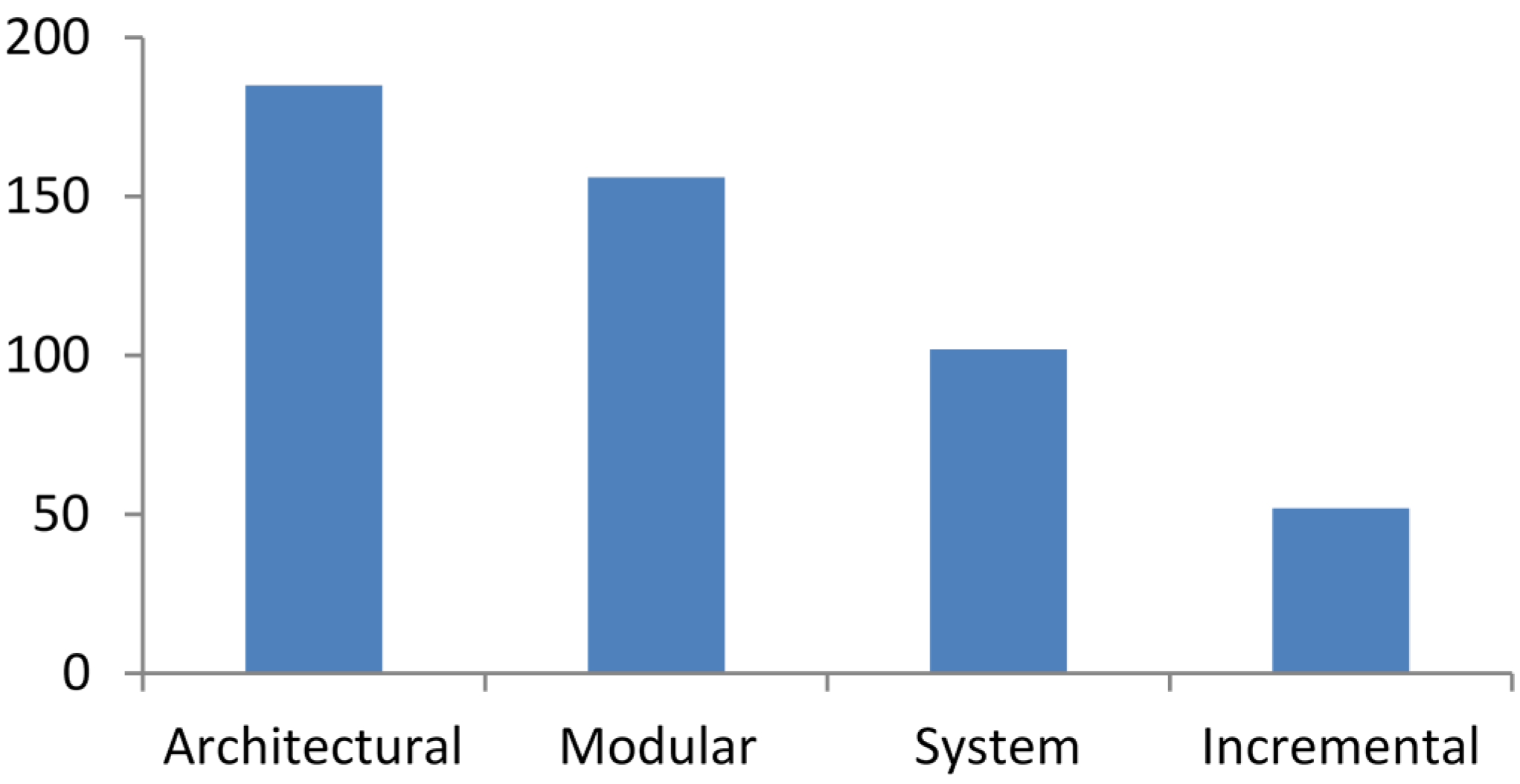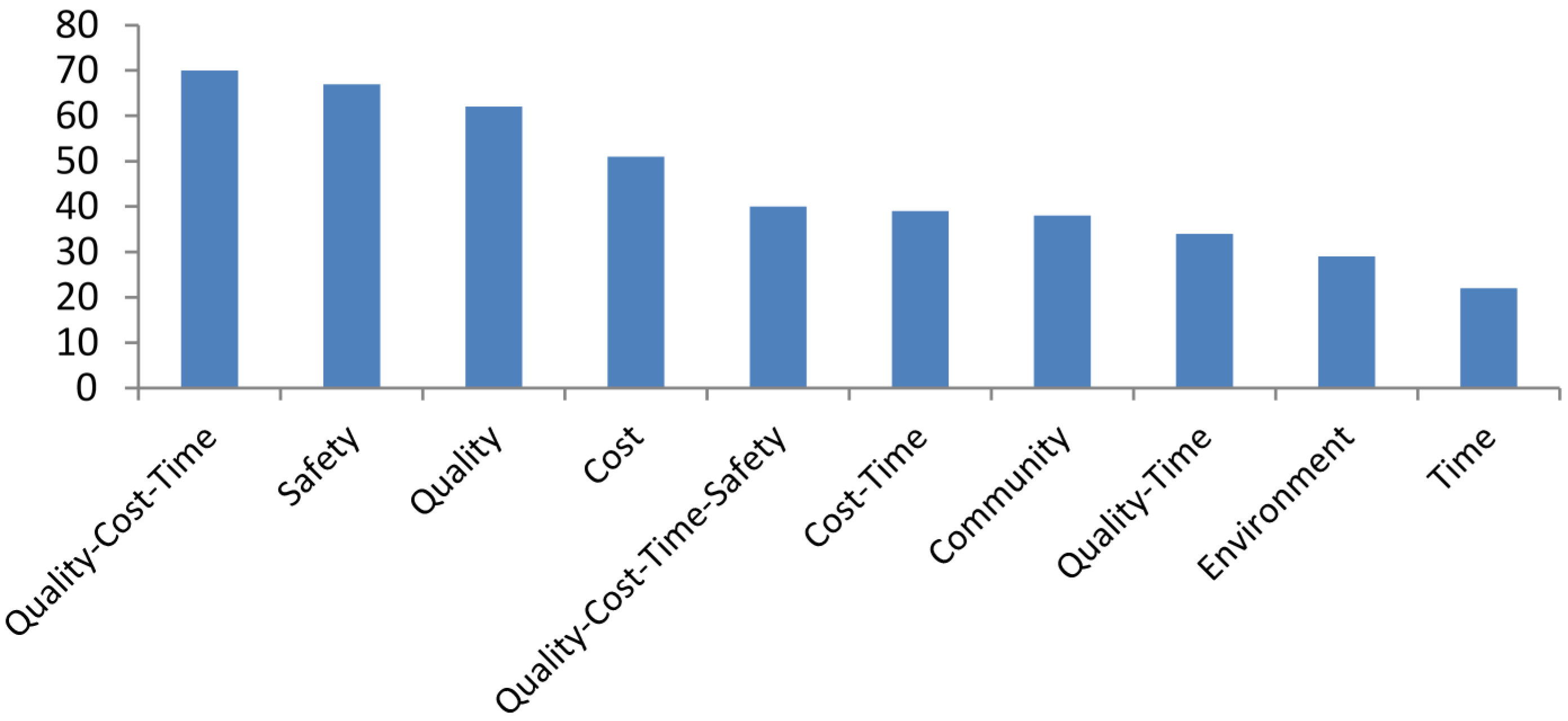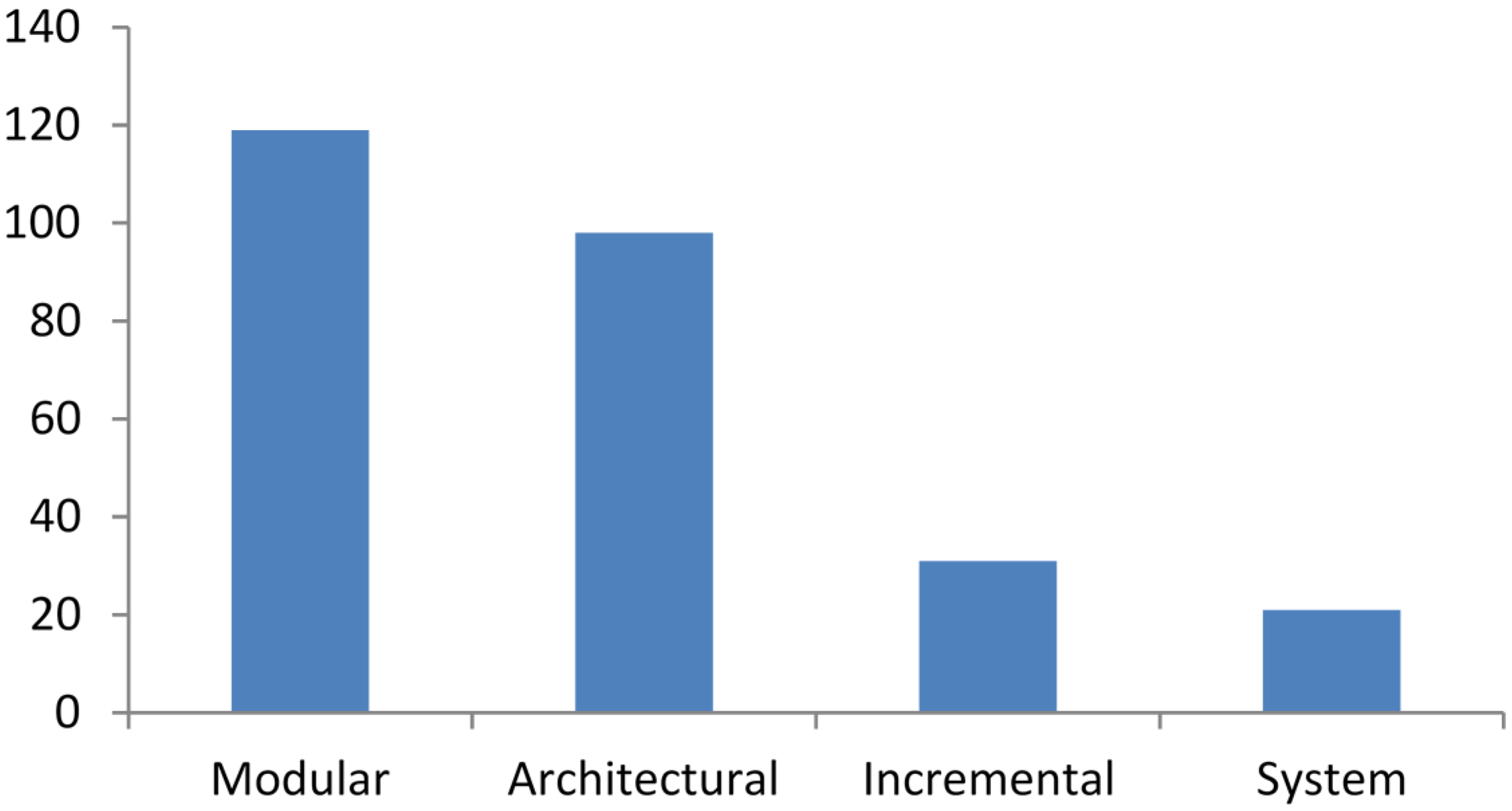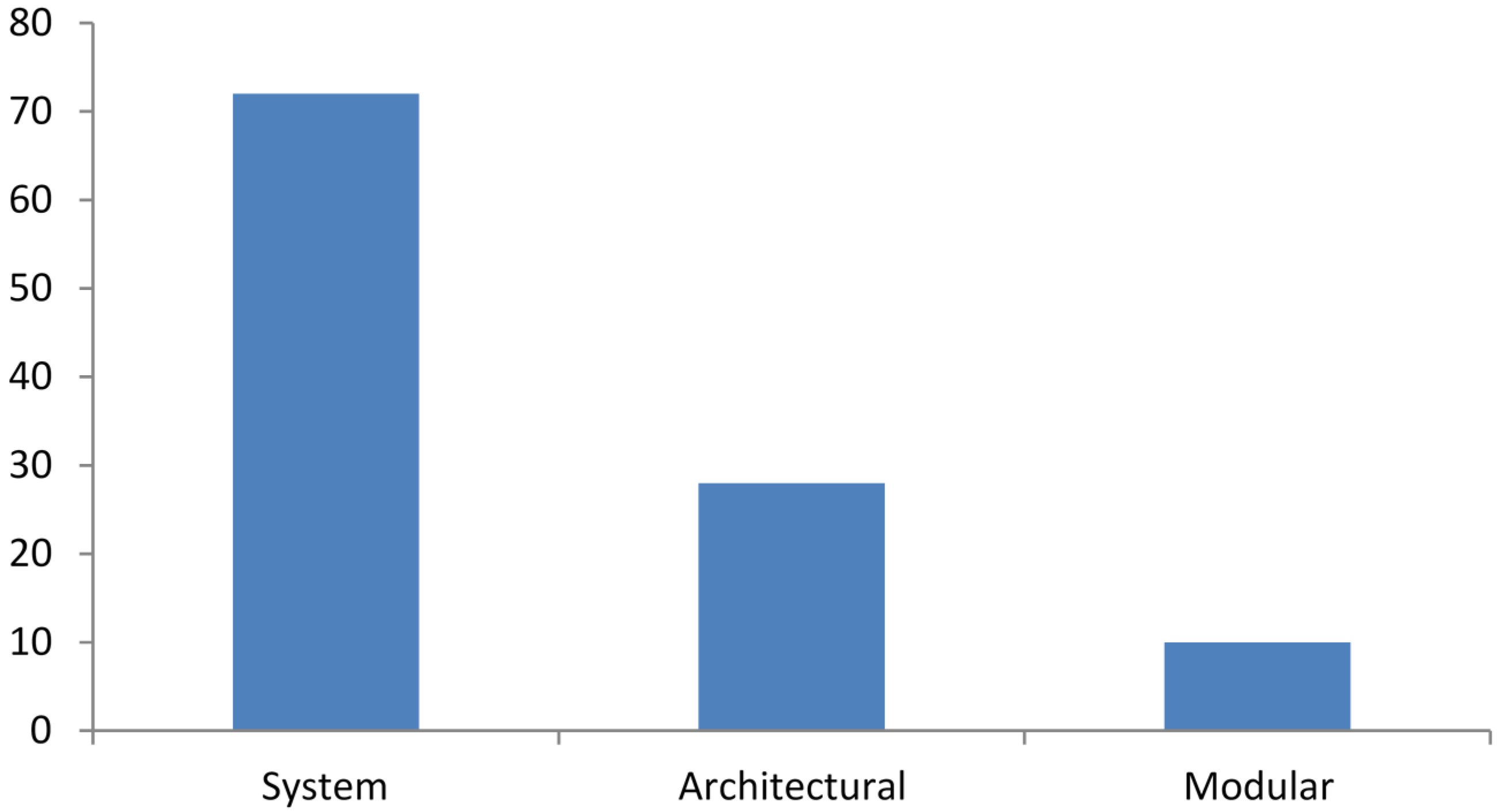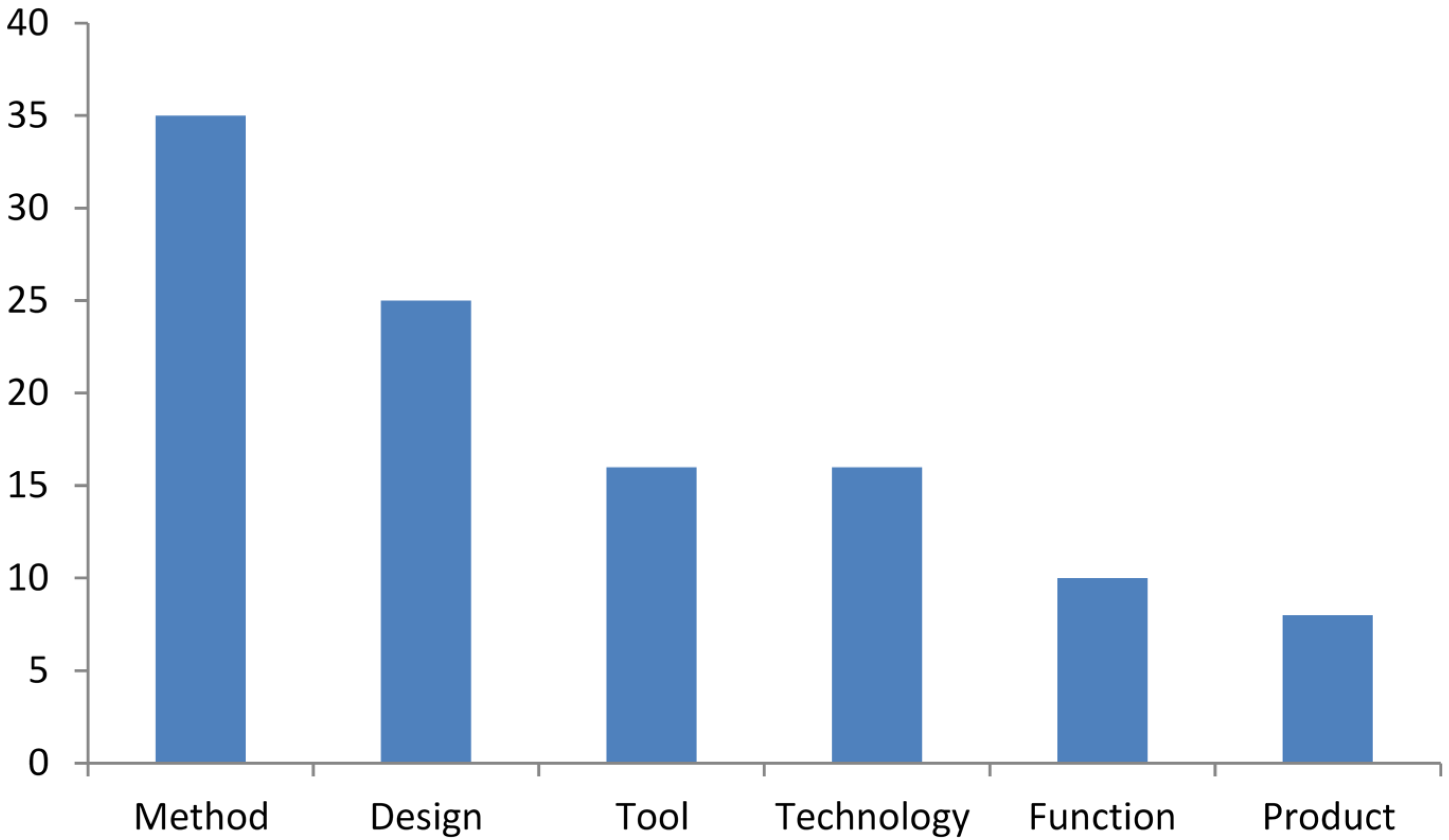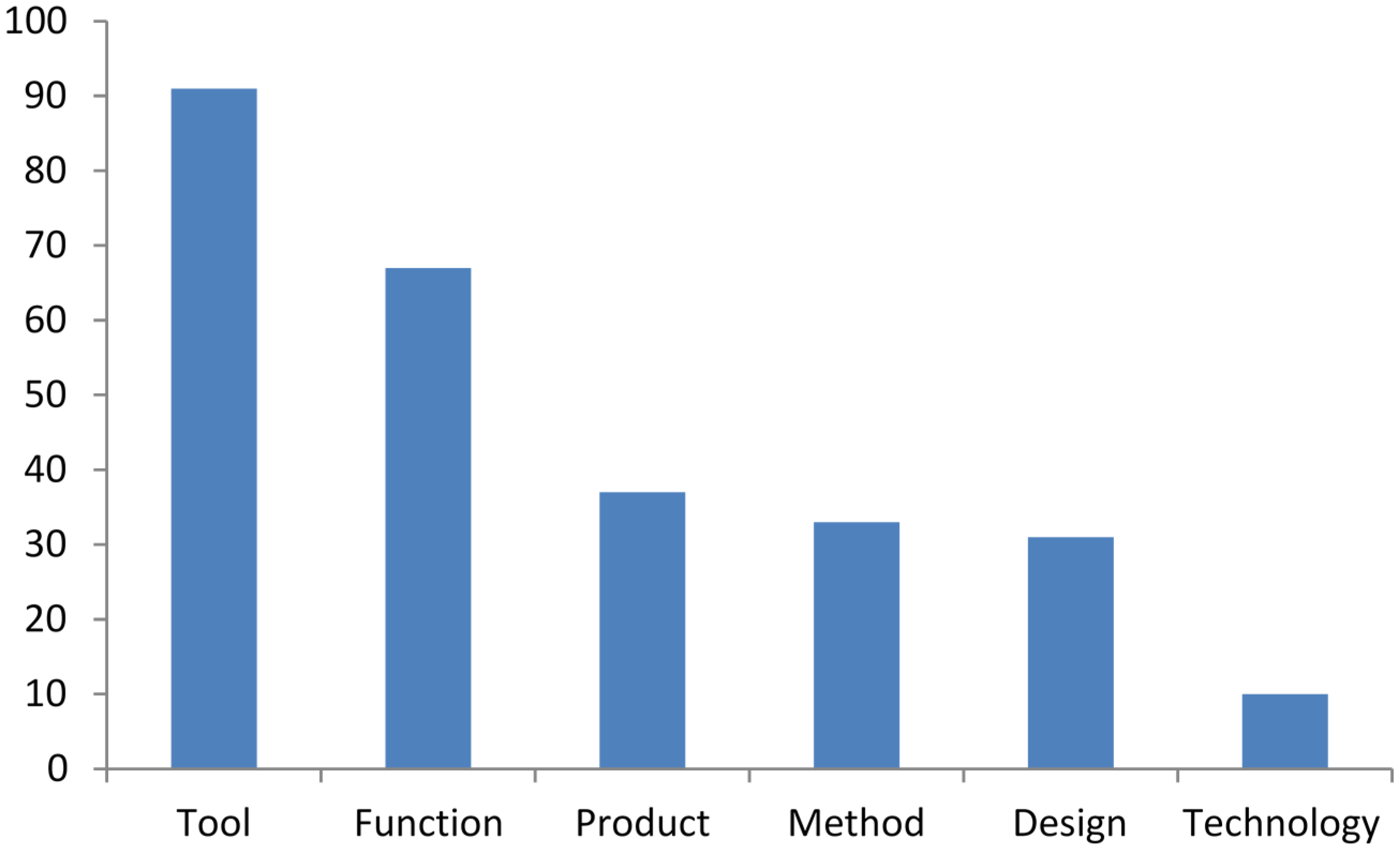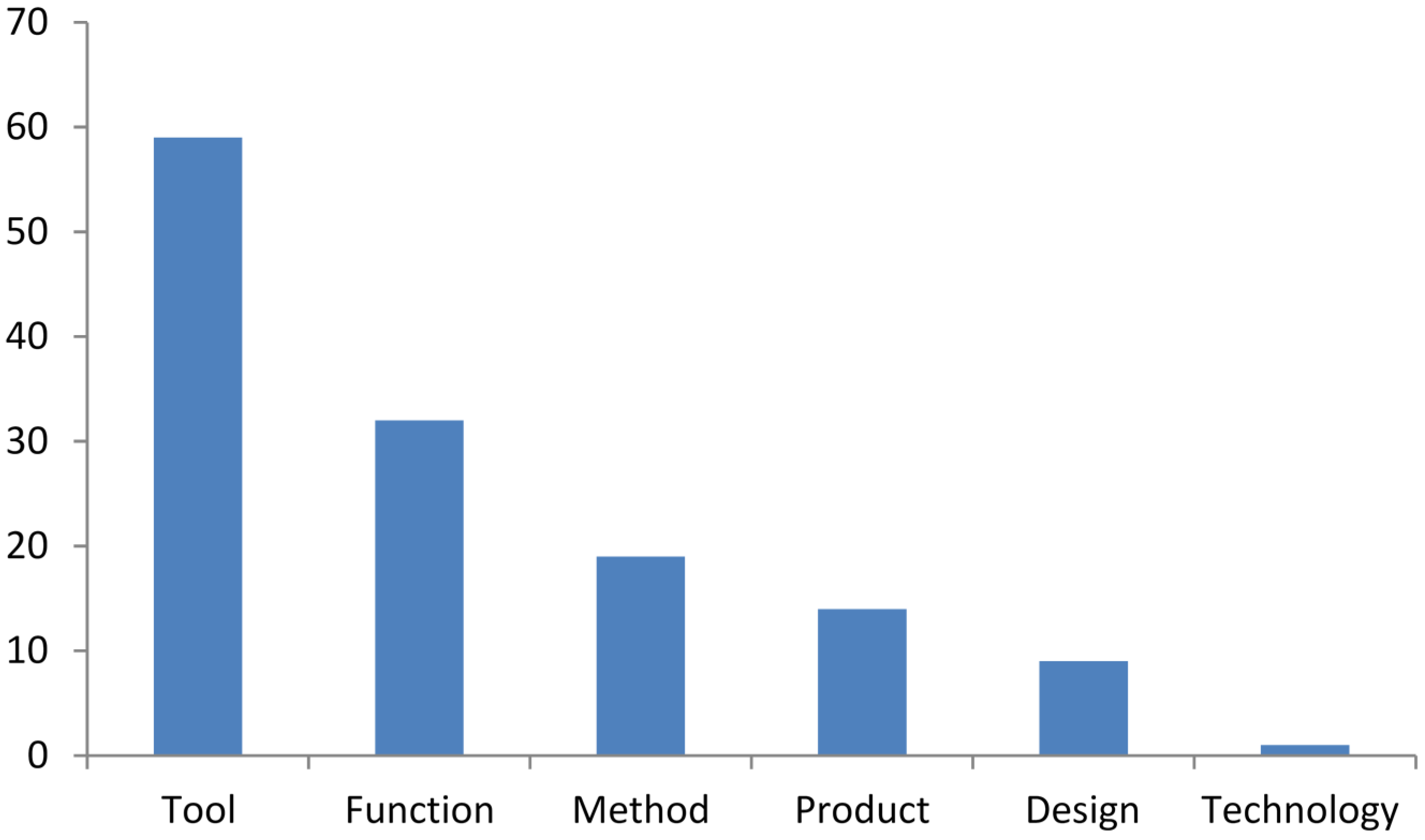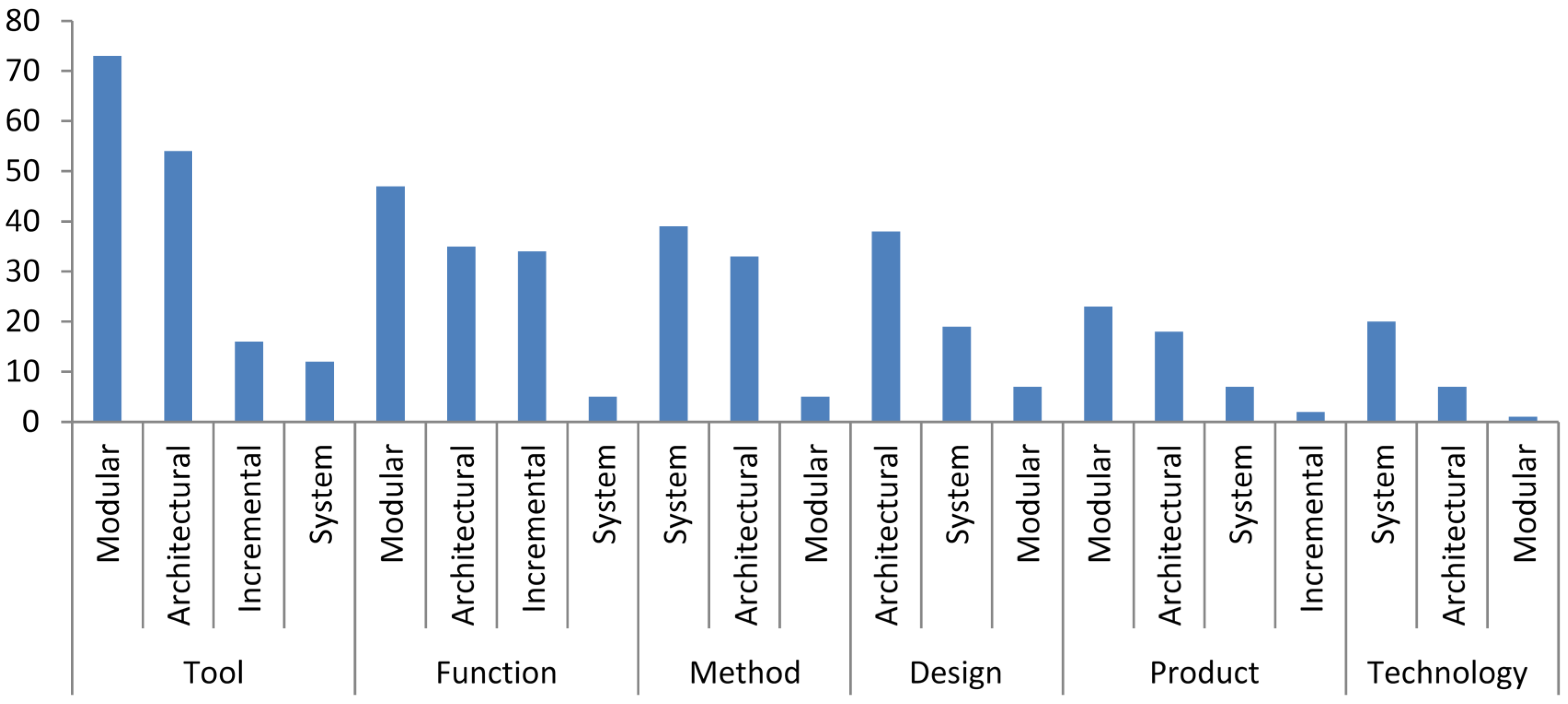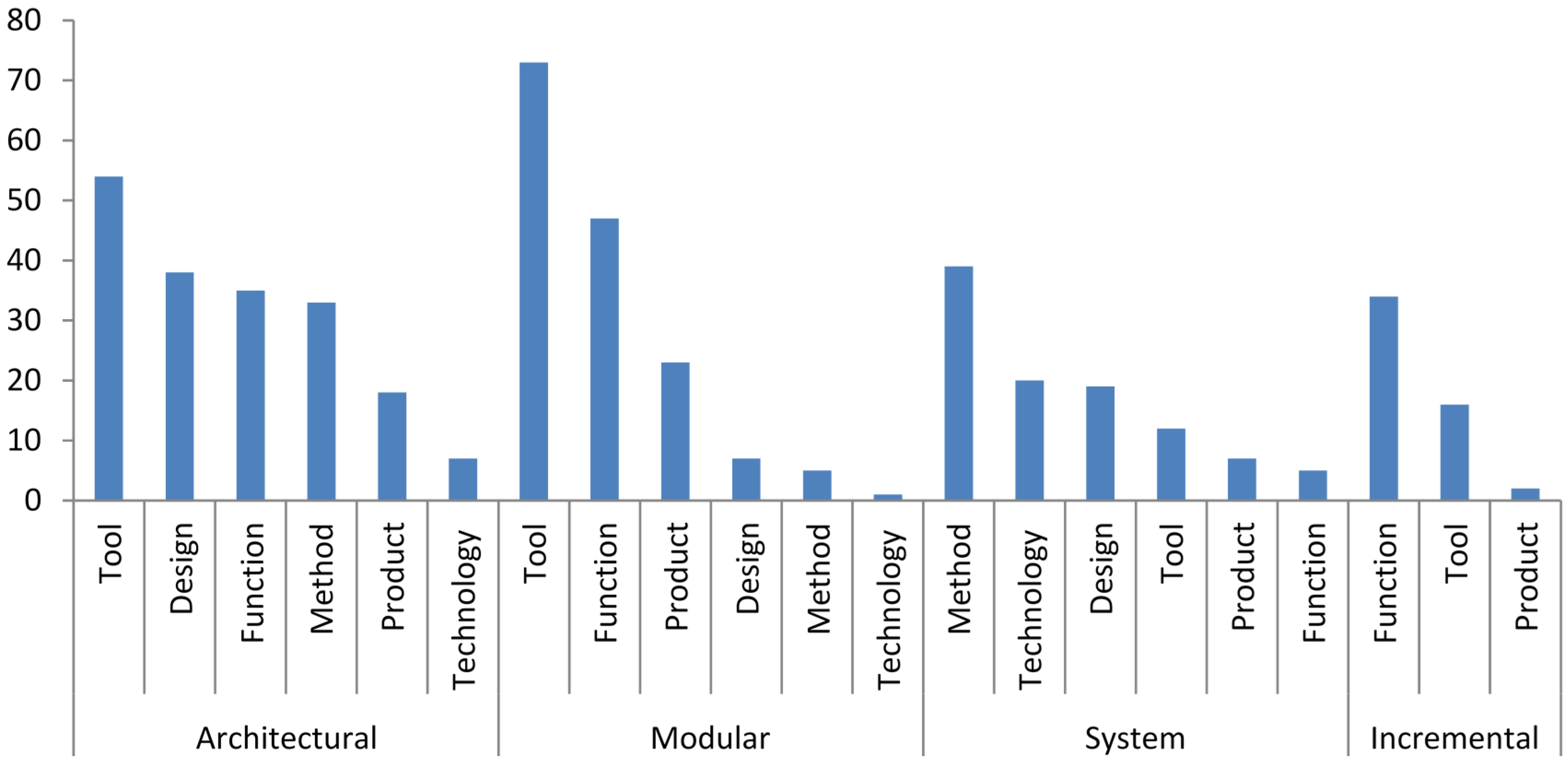1. Introduction
The Construction industry is critical to the functioning of a domestic economy in many countries [
1]. In New Zealand, the construction industry is one of the largest sectors of the economy accounting for 8% of total employment in the country [
2]. However, in spite of its importance to the national economy in terms of size, the construction industry seems to be lagging other sectors in terms of productivity [
3]. In 2010, the construction industry in New Zealand established the Building and Construction Sector Productivity Partnership to actively address the issue of low productivity in the sector. Although the early focus was on identifying and quantifying the problems that lead to low productivity, over the recent years the focus has shifted to problem solving and addressing the cultural and mechanistic change that is needed to resolve the well documented issue [
3].
One of the areas that the partnership has identified as critical for achieving significant improvements in the sector’s productivity is innovation. The ultimate goal of 20% productivity improvement by 2020 cannot be achieved by repeating the old ways of doing things. New innovative approaches are required in order to significantly improve performance at the same cost or maintain the same level of performance at much lower cost. Unfortunately the construction industry is one of the least innovative sectors compared to other industries such as manufacturing and traditional services [
4]. The research and development report produced by Statistics New Zealand indicates that R&D expenditure in the construction industry accounts for a low 5% of the total expenditure in the sector [
5]. Indeed, this problem is not limited to New Zealand as internationally the construction industry is seen as a traditional or low-technology sector with low levels of expenditure on activities associated with innovation [
6].
Furthermore, it appears that the link between innovation and productivity in construction industry is not well understood. Loosemore [
7] observes that in spite of many recent developments in the field of construction innovation, none of these studies feature in the mainstream construction productivity literature.
In contrast, the link between productivity and innovation has been well researched and explored in the manufacturing literature [
8]. However, while certain parallels can be drawn from the manufacturing literature, it is generally agreed that there are significant differences between manufacturing and construction. Koskela and Vrijhoef [
9] identified the one-of-a-kind nature of construction project, site production, temporary multi organization and regulatory intervention, as differentiating characteristics of the construction industry accounting for lower innovation. Reichstein
et al. [
4] also identified a number of “liabilities” which sets construction industry apart from other innovative industries such as manufacturing. These are Immobility, Project-based, Uncertainty of demand, Smallness, Separation and Assembly.
There is a need for more construction specific research to explore the relationship between innovation and productivity. The authors contend that while productivity is a well-defined term, innovation in contrast is poorly defined for the construction industry and is only understood in abstract terms. This is a major obstacle in the attempt to clarify the relationship between innovation and productivity in the construction industry. The study presented in this paper, aims to make a contribution in this area by demonstrating the diversity of various types of innovation present in a construction project and the varying degrees of impact these innovations have on productivity indicators.
The paper will first present this classification system from a theoretical perspective and illustrates how it can be used to better understand the relationship between innovation and productivity. The use of this classification system is then demonstrated by applying it to a database of 500 innovations reported by the construction alliance, the Stronger Christchurch Infrastructure Rebuild Team (SCIRT), responsible for rebuilding the horizontal infrastructure after the earthquakes in Christchurch. SCIRT is an organisation who put innovation as one of the main key performance indictors (KPIs) for its construction project delivery team. The results will highlight the diversity of innovation types that have been reported by the alliance group, and the classification system used in the paper makes sense of these innovations, and suggests ways of improving productivity through innovation use in construction.
2. Defining Innovation
Productivity is generally defined as a ratio between output produced and input used [
10]. For instance, labour productivity can be calculated as a ratio of hours of labour worked (input) and units produced (output). More holistic definitions of productivity include a number of performance dimensions for units of input and output, such as quality, cost, time and safety. Innovation on the other hand is more ambiguous in its definition. Brown [
11] provides a broad definition of innovation as “
doing things differently or better across products, processes or procedures for added value and/or performance”. West and Altink [
12] provide a similar, but perhaps more complete, definition of innovation as the “intentional introduction and application within a role, group or organisation of ideas, processes, products or procedures, new to the relevant unit of adoption, designed to significantly benefit the individual, the group, the organisation or the wider society”.
When comparing the above definitions and other popular definitions of innovation in the literature, three key defining elements of innovation can be identified. First is the type of innovative idea or invention. The Oslo Manual on collecting and interpreting innovation data [
13] outlines four types of innovations: product, process, marketing and organisational. Second is novelty. The minimum entry level for an innovation is that it must be novel or “new to the firm” [
13]. Degree of novelty or “newness” can be defined as the extent of uncertainty associated with the implementation of the innovative idea within the context of its application [
14]. Slaughter [
15] divided the Novelty of the construction innovation in five different levels of Incremental, Modular, Architectural, System and Critical. The third is benefit or improvements in performance. In construction, traditionally performance has been measured in terms of cost, time, quality and safety [
16]. Recently, environmental measures have also become an important performance indicator in construction projects [
17].
Each of these elements (type, novelty, and benefit) can alter the significance and type of the impact that a given innovation has on productivity. In terms of type, whether the innovative ideas are a product, process or an organisational method results in different type of impact on productivity. For instance, process and organisational innovations are mainly concerned with the construction phase and thus will have a direct impact on the project’s productivity performance. On the other hand, product innovation may have much less significant impact on the production phase but much larger impact once the building or infrastructure is in operation. In terms of novelty, the degree of novelty determines the significance of the impact the given innovation may have on productivity. For instance, an incremental change results in much less significant impact on performance than a more radical and disruptive change. Finally, different innovations would improve different set of performance indicators, thus having very different impacts on productivity.
It is therefore proposed that in order to better determine the impact and nature of the relationship between given innovations and overall project productivity, types of innovation, novelty and the specific performance indicators being improved must first be determined. This requires an innovation classification system, which can be used to categorise the innovations implemented in a project.
3. Innovation Classification System
A multi-dimensional classification system is presented, based on review of relevant construction and innovation management literature regarding the elements discussed previously. After a review of the literature, it was found that the most commonly accepted innovation classifications have mainly been developed by analysing innovation within the manufacturing and services context. As mentioned previously, there are significant differences between construction and other industries. Consequently, in order to develop an appropriate innovation classification system for the construction industry, modifications were made to these classification systems and where appropriate new categories were developed. This section will briefly outline each dimension and provide a definition for each classification category.
Innovation Type: The authors found it necessary to distinguish between development or utilisation of innovative construction materials or componentry and the development of innovative designs and features for buildings or infrastructures. Therefore, the product innovation category was limited to cover new materials or products used in the construction phase, and a new category was added, called Design, to account for the innovative design features introduced at the design phase of the project. Furthermore, guided by the construction technology classification system developed by Tatum [
18], the process innovation category was divided into two sub-categories of Tools and Function.
- -
Product: Product Innovation involves all new construction materials and products developed in the project or introduced to the project and used within the construction process.
- -
Design: Design Innovation is related to new and innovative plans, designs, sketches or concepts for the final building or infrastructure that is being developed in the project.
- -
Tool: The Tool Innovation involves the development or implementation of novel construction machinery equipment or tools in the construction project.
- -
Function: The Functional Innovation refers to new tasks developed or introduced in the construction project and associated management processes.
After further consultation with industry experts two other categories were added where a combination of the previous sub-categories could exist:
- -
Technology (Design + Product): The New Technology refers to the new design that is coupled with a new material or product.
- -
Method (Tool + Function): The method innovation is the combination of the Tool and Function Innovation that involve both a new tool or equipment and new tasks that are usually related to the new tool.
Innovation Novelty: Typically the innovation literature distinguishes between incremental and radical innovations. However, Slaughter [
15] provides a more detailed categorisation of novelty within construction innovation context. These categories are Incremental, Modular, Architectural, System and Critical.
- -
Incremental: Incremental Innovation is a small change, based upon current knowledge and experience. It is often the result of continuous improvement initiatives and on-the-job problem solving.
- -
Modular: Modular Innovation entails a significant level of novelty in one area of a system, but without impacting the other components of the system. Modular innovations may be developed within an organization and implemented without much negotiation with parties involved in the development or selection of other components.
- -
Architectural: Architectural Innovation involves a small change within a component of a system, which results in major changes in the links to other components and systems. The distinction between modular and architectural innovations is made on the region of the change and, specifically, the degree of interaction with other components of the system.
- -
System: System Innovations are identified through their integration of multiple independent innovations that must work together to perform new functions or improve the facility performance as a whole.
- -
Critical: Critical Innovation is a breakthrough in science or technology that often changes the character and nature of an industry. While incremental innovations occur constantly, critical innovations are rare and unpredictable in their appearance and in their impacts.
Innovation Benefit: This dimension of the classification system deals with the type of performance improvement that is achieved through implementation of the new innovative ideas. As mentioned previously, the following performance indicators will be used to distinguish between the types of benefits that are delivered by the given innovations.
- -
Cost: Direct cost savings or better utilisation of resources.
- -
Time: Reduction in lead-times or increasing speed for the project or sub-tasks.
- -
Quality: Improvements in degree of conformance with specifications and/or satisfaction of stakeholders with the outputs of the construction project.
- -
Safety: Improving safety, health and wellbeing of the employees and public during and after the construction project.
- -
Environment: Reducing adverse impact of the construction processes as well as the final building or infrastructure on the natural environment.
- -
Community: Reducing adverse impact on communities affected by the construction project and improving communication with the stakeholders.
4. Case Study
SCIRT is an organisation established under an alliance agreement and is responsible for rebuilding horizontal infrastructure in Christchurch following the earthquakes of 2010 and 2011. Innovation was given a special consideration from the outset, when the SCIRT alliance was formed. In fact, members of the alliance were encouraged to innovate and report on their innovations on a monthly basis as one of their KPIs. These KPIs were linked directly to the pay/reward aspect of the contract. As a result, the alliance members had ample motivation to report their innovations. To date more than 500 innovations have been reported by SCIRT. This has provided a unique opportunity to analyse and better understand the relationship between construction innovation and productivity improvements. The authors were given full access to SCIRT’s innovation database. For each reported innovation, the database contained a unique identification number, description of the innovative idea, its potential benefits and information regarding which member organisation had initiated the innovation. Some of the reported innovations were also accompanied by pictures or sketches to better describe the innovation. Each of the reported innovations were analysed and categorised based on the innovation classification system outlined in the previous section. The categorisation process was carried out mainly by one researcher to ensure consistency of interpretation across the data set. Once completed, 20 innovations were selected randomly and categorised by two other researchers using the classification system. This was done to make sure the classification system was being applied appropriately. Any uncertainty around the definition was clarified through this process.
5. Results
In order to better understand the spread of various categorisations of innovations developed by SCIRT, the data was analysed using pivot-table functionality of MS Excel. A pairwise analysis was also conducted to identify any potential trends which may lead to insights about the nature of innovation activity at SCIRT. The following section presents the summary of the results from this analysis.
5.1. Spread of Innovation
Figure 1,
Figure 2 and
Figure 3 represent the spread of innovation categories in each dimension of the classification system: type, novelty and benefit. Most innovations in the SCIRT database seem to be made up of tools or functions in terms of innovation type, and modular or architectural in terms of novelty. They also appear to deliver a wide spread of performance benefits, mainly dominated by quality, time and cost.
Figure 1.
Innovation classification based on Type.
Figure 1.
Innovation classification based on Type.
Figure 2.
Innovation classification based on Novelty.
Figure 2.
Innovation classification based on Novelty.
Figure 3.
Innovation classification based on Benefit.
Figure 3.
Innovation classification based on Benefit.
5.2. Pairwise Analysis
The data was also analysed to identify emerging trends that would provide more insight in to the relationship between the three dimensions of the innovation classification system. When looking at the spread of innovation based on a pair of two dimensions of benefit and novelty, an interesting trend emerged. As illustrated in
Figure 4, it appears that architectural and modular categories of innovation are more focused on delivering a single benefit. On the other hand, system category of innovation seems to be the one that mostly delivers a combination of quality, time and cost benefits (see
Figure 5). Modular innovation also appears to be the most prevalent category which focused on the indirect productivity improvements through safety, environment and community (see
Figure 6).
Figure 4.
Innovation novelty categories that focused on delivering a single benefit.
Figure 4.
Innovation novelty categories that focused on delivering a single benefit.
Figure 5.
Innovation novelty categories that delivered a combination of quality-time-cost benefit.
Figure 5.
Innovation novelty categories that delivered a combination of quality-time-cost benefit.
Figure 6.
Innovation novelty categories that focused on either sustainability, safety or community.
Figure 6.
Innovation novelty categories that focused on either sustainability, safety or community.
When looking at the pair of innovation types and benefits similar trends appear. As illustrated in
Figure 7, the majority of innovations are delivering a combination of direct productivity improvement benefits such as quality, time and cost, were from the two categories of design and method. On the other hand, function and tool categories seem to be more focused on delivering a single benefit (see
Figure 8). Tools also appear to be the most prevalent type of innovation that deliver either safety, environment or community benefits (see
Figure 9).
Analysis of the pair of type and novelty also reveals some interesting trends. As illustrated in
Figure 10, design innovation was dominated by architectural level of novelty, while product innovation was split between modular and architectural. Technology innovation (design + product) on the other hand was mainly dominated by system level of novelty. Modular and architectural innovations made up the majority of the tools and functions, while those innovations classified as method were mainly system or architectural innovations.
Figure 11 also illustrates that the system level of novelty was mainly prevalent in methods, while modular innovations were mostly found under the tool and function categories. Architectural innovations were spread amongst tools, designs, functions and methods. Also, it was found that most incremental innovations were under the tools category.
Figure 7.
Innovation types that delivered a combination of quality-time-cost benefit.
Figure 7.
Innovation types that delivered a combination of quality-time-cost benefit.
Figure 8.
Innovation types that focused on delivering a single benefit.
Figure 8.
Innovation types that focused on delivering a single benefit.
Figure 9.
Innovation types that focused on either sustainability, safety or community.
Figure 9.
Innovation types that focused on either sustainability, safety or community.
Figure 10.
Degree of novelty of various types of innovation.
Figure 10.
Degree of novelty of various types of innovation.
Figure 11.
Spread of innovation types for each level of novelty.
Figure 11.
Spread of innovation types for each level of novelty.
6. Discussions
The results of the analysis of 500 reported innovations by the alliance group, SCIRT, clearly demonstrate the diversity of types, degree of novelty and performance improvement benefits among construction innovations. The trends presented in the previous section have all emerged naturally based on the organisational dynamics and culture present among the member organisations as well as within the virtual alliance organisation. Given that innovation KPI reporting was linked to pay/reward system for the member organisations, there was motivation for all parties to look for opportunities to innovate. However, the data shows that most of the reported innovations were tools or functions that were developed to overcome immediate problems facing the operational teams. As a result, most of these innovations were modular or architectural in terms of novelty. This indicates that most reported innovative solutions were developed to either solve localised problems or issues arising at the interface of operational sub-systems. The data also shows that when architectural and modular innovations were dominant, the reported innovations were mainly focused on a single aspect of performance improvement. In contrast, the results show that when more sophisticated types of innovation such as technology and methods were developed, the impact was more widespread and significant, delivering benefits along multiple dimensions of performance such quality, time and cost.
Given that the reported innovations in the SCIRT database were developed without consideration given to the types of innovation, degrees of novelty or performance improvement benefits, they were all treated the same. The KPI associated with innovation simply counted the number of innovations reported by the member organisations. The main reason for this equal treatment of the reported innovations is lack of in-depth understanding of various categorisations of innovation by the SCIRT management team. Consequently, they missed the opportunity to guide and direct the innovation efforts of the alliance member organisations towards specific types of innovation which could lead to specific aspects of productivity and performance improvement.
One important point with respect to future application of the classification system to other construction projects is the uncertainty associated with matching the definitions of the various categories of the classification system with the information provided about the particular innovation. Although this was not a major issue in the case of innovations in the SCIRT database, it is still a notable concern for future applications. While applying the classification system in the case study, it was clearly evident that this uncertainty was directly related to the amount and quality of information provided about the innovation. Given that in this case the classification system was applied retrospectively, the researchers did not have any influence over how data about the innovations was collected and reported. It is therefore suggested that if the proposed classification system is used for development of a KPI system, a data collection template is designed based on the definitions of the various categories. This could for instance take the form of a questionnaire with specific questions around novelty, benefits and type of innovation, which would ensure that adequate information is available for classifying the particular innovation.
7. Conclusions
In conclusion, the results of the analysis illustrate the need for a more in-depth understanding of innovation in construction. The innovation classification system presented in this study provides a practical tool for researchers and practitioners in the field of construction management, to not only better understand the relationship between innovation and productivity, but to also put in place mechanisms to influence the types of innovation developed in their projects with the aim of maximising their productivity performance. This classification system can be used by construction organisations and alliances in the future to develop more detailed methods of calculating innovation KPIs, based on the innovation type, novelty and benefits factors. In such methods, different weightings can be given to each factor as a mechanism to encourage certain types of innovation, with higher levels of novelty and focusing on specific combination of performance indicators that are tailored to the specific requirement of the construction project. For instance, in projects where the Green Construction approach is adopted, the system can be set up to encourage more environmental benefits, whereas if Prevention through Design (PtD) approach is utilised, it can be configured to emphasise safety related innovations in products and designs. Future research should look into expanding the application of the innovation classification system from productivity improvement to these emerging construction paradigms.

